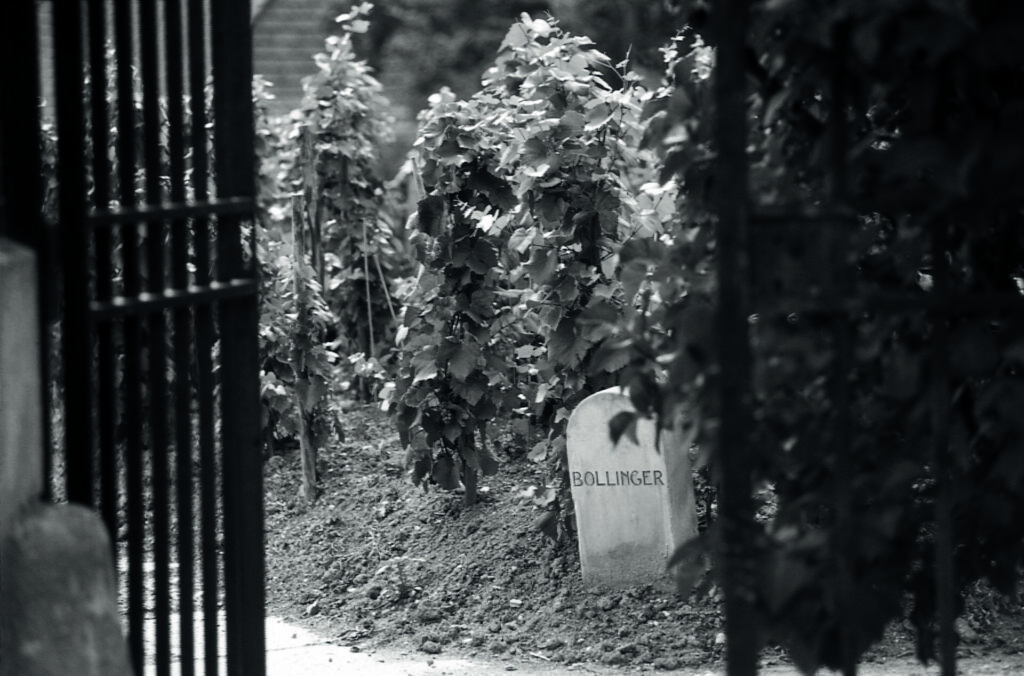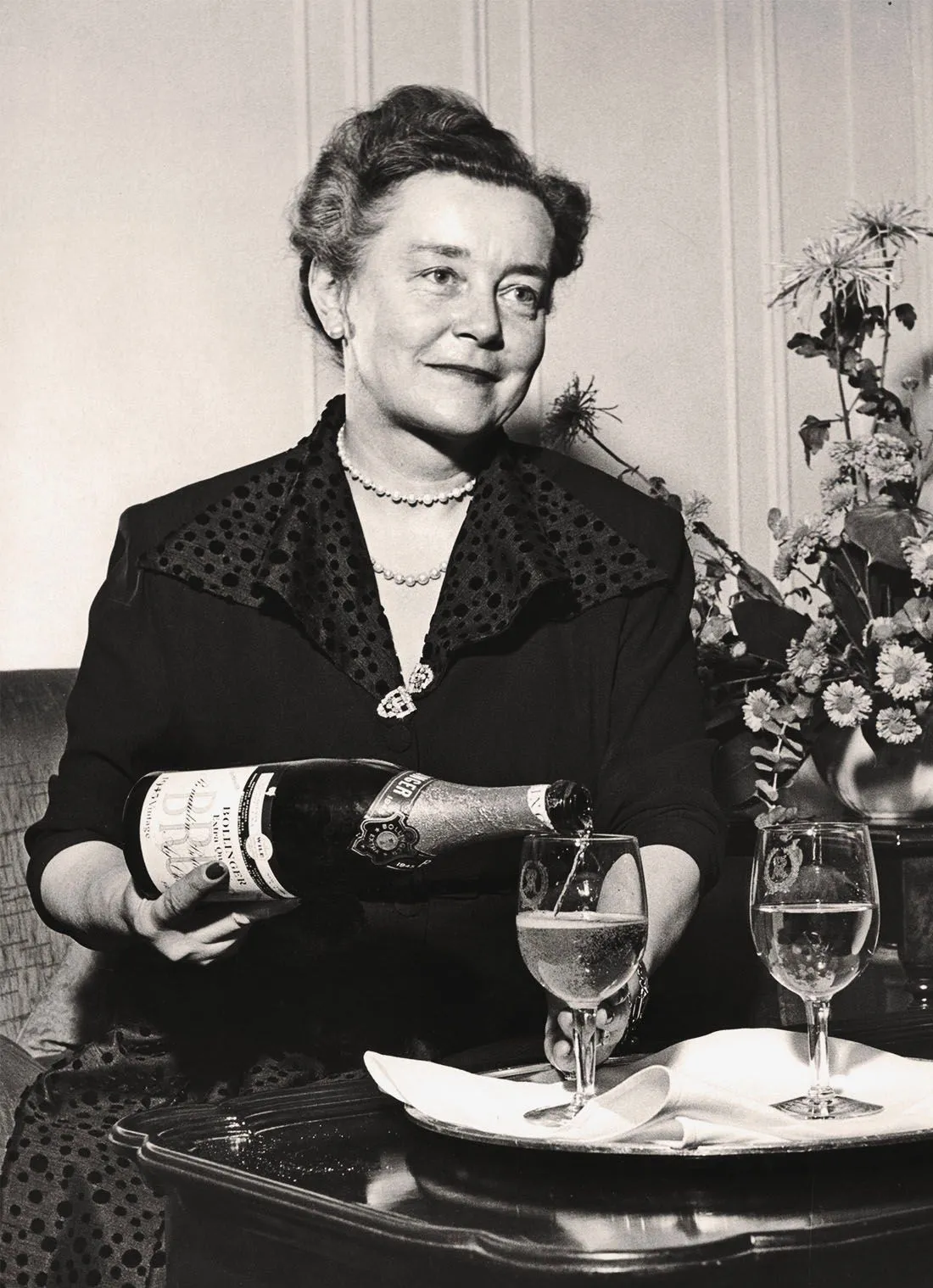Champagne has not only upheld its esteemed status but has continued to enhance its reputation throughout history as a sophisticated and versatile wine that accompanies life and its celebrations — making it a go-to choice for toasting special moments. Maison Bollinger‘s commitment to French craftsmanship in Aÿ in the Champagne region celebrates deep-rooted family tradition and an affinity for the intricate and delightful Pinot Noir grape.

Boasting two Royal Warrants from the British court as well as a seal of approval from none other than James Bond, Champagne Bollinger is “an enterprise belonging to the living French patrimony.” At least, so says 6th generation family member Cyril Delarue, over a champagne-paired lunch at the house of Lily Bollinger, the “Grande Dame” of Champagne and one of the pivotal Bollinger family members. Surrounded by a great deal of toile-style wallpaper within the bastide, Delarue recounts the house’s history and discusses its future, as it will soon be turned into a boutique hotel and spa.
Everything within the Bollinger family has a cast of cinematic glamor. Take their status as James Bond’s favorite champagne. Despite Bollinger champagne appearing in several Bond films (he’s shown overall imbibing 65 glasses of the stuff), this was never part of a formal endorsement. Instead, it was une poignée de main, a handshake deal, involving nothing more than a friendly exchange of few boxes of the Special Cuvée.
The Maison itself dates to 1829 when three gentlemen from different walks of life joined together for a daring venture. Athanase de Villermont had inherited an estate in the small, dreamy village of Aÿ, where he immediately sensed an extraordinary potential for wine. Although his noble standing prohibited direct involvement in commerce, he enlisted the expertise of the German wine merchant Joseph (later renamed Jacques) Bollinger, who excelled in the local wine trade. Bollinger then entrusted local Champenois and Ruinart alum, Paul Renaudin, with the management of the cellar. And so, Renaudin-Bollinger & Cie was founded in February 1829. The small winery was housed in the Villermont family house. Today, it serves as the site for the Bollinger cellars and visitor center, poised to transform into the central hub of the Bollinger estate as the brand embarks on expansion plans, including new barrel rooms, a hotel, and a restaurant that promise to invigorate the village in the years to put it on the same level as the nearby popular tourist destinations of Reims and Épernay.
Pinot Noir wines from the town of Aÿ were already highly esteemed at the French court before Bollinger’s establishment. They were cherished by King Henri IV for their captivating, occasionally earthy fragrance and a gentle, rounded, silky, yet still well-structured texture — a most sensuous wine. And so it is no mistake that about 60% of the planted varieties at Bollinger are pinot noir, which coincidentally reflects the percentage of the variety necessary for the Special Cuvée blend. Champagne is usually primarily made from chardonnay or pinot noir grapes, with Bollinger going for the latter (which is why the brand does not have a Blanc de Blancs wine, which would be entirely comprised of chardonnay). Instead, it is the pinot noir that gives structure to the wine with its intricate and robust characteristics. Bollinger wines are extremely elegant and well-balanced across the board. They are characterized by the fruit’s full palette of aromas.
While it is normal practice for houses to buy the majority of their grapes from winegrowers, Champagne Bollinger has established its own vineyards in the heart of the most prestigious crus in Champagne, spanning seven vineyards: Aÿ, Avenay, Tauxières, Louvois, and Verzenay for Pinot Noir; the Montagne de Reims and Cuis on the Côte des Blancs for Chardonnay; and Champvoisy for Meunier in the Vallée de la Marne. But Bollinger vineyards are also easily recognized as some of the most tightly planted in the world, not to waste any of that valuable Champagne acreage, creating a truly recognizable landscape. With 79 hectares of vineyards, comprising 85% Grand and Premier crus, Bollinger produces exceptional champagne, affirming the realization of Villermont’s vision.

A truly outstanding aspect of the estate includes two plots, the Clos Saint-Jacques and Chaudes Terres, which remained unscathed by the phylloxera blight that ravaged European vineyards in the 19th century. These ungrafted vines are meticulously cared for by hand and propagated using a technique known as provignage, ensuring the preservation of this extraordinary heritage, from which the highly exclusive Vieilles Vignes Françaises cuvée is crafted. And they produce quite a special champagne.

While the house was making exceptional wines all along, it was in 1899 when Georges Bollinger, the fourth child of Jacques Bollinger, assumed leadership of the house, and went on to significantly influence the character of the wine as it stands today. Following in the footsteps of his elder brother, he faced one of the most complex periods in the history of wine in France – the phylloxera epidemic and the turmoil of the Great War. The destructive North American insect called phylloxera plagued the vineyards all across Europe, requiring growers to replant every vine using American rootstock, the only defense against the pest. This monumental undertaking spanned two decades, making Bollinger’s unique distinction of preserving two untouched plots (the Vieilles Vignes Françaises) a rarity amongst wine houses. Nonetheless, the Great War brought military activity to the Champagne region due to its strategic location, causing damage to its cellars, subjecting vineyards to gunfire, and conscripting locals who worked for the brand, creating a labor shortage.
Champagne served as a battleground from 1914 to 1918, strategically positioned on the route from Germany to Paris. This wartime period posed a significant threat to the very existence of champagne, endangering both its sources and markets. Over the course of three and a half years of trench warfare, the German lines camped 1,500 meters northeast of Reims, subjecting the city to 1051 days of relentless bombing. The cathedral, a symbol of cultural heritage, suffered extensive damage, with the city ultimately left 90% destroyed by the war’s end.
A remarkable moment in this tumultuous history was the victorious counter-offensive of the Battle of the Marne, which saved Épernay on September 11th and Reims on the 13th. While the town of Aÿ fell into German hands, with wine houses serving as their posts, Bollinger remarkably escaped the same fate, possibly owing to its German heritage. In the shadows of World War II, Bollinger took clandestine measures to preserve its heritage, creating a secret cellar to store its most valuable wines. This cellar was discovered in 2016, marking a hidden chapter in the storied history of this renowned champagne house.
While serving as a town councilor during this time, Georges persevered but passed away before the war ended. In 1920, his son Jacques assumed the helm at the young age of 24. Jacques committed to expanding the vineyards while at the head of Champagne Bollinger, nurturing a vision to gradually reclaim a plot that would ultimately become iconic for the house: La Côte aux Enfants. This distinctive vineyard, named either for the hill where children used to sled in winter, or as a sly twist on aux enfers (“to hell”) due to its steep slope, stands as a testament to Bollinger’s expertise in cultivating pinot noir.

Grapes from this legendary parcel undergo an ancient method that involves fermenting grapes in a vat without removing stems or crushing them. This approach necessitates harvesting the grapes at optimal ripeness when the stems have hardened to avoid any vegetal flavors. The technique is ideally suited for pinot noir, imparting aromatic complexity and enhancing the wine’s structural qualities. Today, it stands out as one of Bollinger’s distinguished hallmarks, a true mastery of pinot noir. “The joke internally is that we spend more time making the red than the champagne,” says Delarue. The brand actually does produce a small batch of red wine from the single plot alongside its esteemed champagnes.
Georges steered the Champagne House through an economic crisis and another World War but passed away in 1941. His death placed his wife, Elisabeth Law de Lauriston-Boubers, at the helm of the house, adding her to the canon of famous Champagne widow-winemakers. (As women did not have full legal rights to work or own businesses until 1965, with exceptions made for widows, or veuves in French.) She stepped into her role with unwavering determination, earning a well-deserved reputation as the Grande Dame of Champagne. While the couple had no children, the vineyards and the precious grapes they yielded became her true darlings. Known affectionately as Lily, Madame Bollinger’s legacy would forever grace the region with her indomitable spirit and passion for crafting (and drinking) exceptional champagne.

Over a span of three decades, Madame Bollinger deftly blended contemporary agricultural practices with the cherished traditions of Champagne. Her resolute commitment to using oak barrels (instead of stainless steel) for vinification spoke volumes, with her firm belief that “Traditional methods are paramount, even when they appear antiquated; the quality of my wines is a testament to this philosophy.” In 1967, she unveiled her own creation, R.D. – Récemment Dégorgé, recently disgorged, groundbreaking champagne aged for several years on its lees, which garnered significant acclaim upon its release.
Madame Bollinger was celebrated as a visionary in Champagne as well as for her warm and charitable nature, as she maintained close relationships with all the winegrowers she worked with. However, she notably refrained from producing rosé, as she chose not to create a drink for the French cocottes of that era. Historically, rosé champagne was associated in France with courtesans, as several high profile royal consorts of the Second Empire made it their signature. (Bollinger’s successors, ironically, later went on to make a highly-renowned rosé champagne.) As a dedicated family woman, Madame Bollinger surrounded herself with those most dear to her, appointing relatives as brand ambassadors and CEOs, and establishing the framework for a brand that would persistently evolve under the profound influence of the Bollinger family.
While Champagne’s liquid gold is found in the vineyards of Bollinger, the heart of it is guarded by time in the cellars. The wines at this estate undergo an extended aging period on the lees, often double or even triple the duration required by the appellation, allowing them to develop their distinct complexity. This extended aging imparts a genuine delicacy and a velvety texture to the wine. As a result, Bollinger’s style is predominantly characterized by a broad spectrum of fruit aromas, skillfully balancing the intensity of exceptional Pinot Noir with the freshness of Chardonnay. These champagnes culminate in a creamy finish, attributed to the vinification in oak barrels and the extended interaction with yeast. In keeping with tradition, Maison Bollinger also keeps the region’s last resident cooper, or barrel maker and repairer, on staff. The highly skilled craft requires great attention to Bollinger’s 4,000 aged barrels, some nearly 100 years old. Thus, an on-site master is needed to craft the keepers of these legendary wines.

Maison Bollinger dedicates its easily identifiable champagne signature to the house vineyards, pinot noir, magnums of reserve wines, barrels, and time. It stresses the importance of time as an ingredient and urges its patrons to crack open the bottle, twist the metal six times, and hear the elegance of the tiny bubbles making their way to the surface. But, most importantly, it reminds us that champagne is not just a libation for celebration but truly a commemoration of all of life’s moments. As Madame Elisabeth Bollinger once said at the London Daily Mail (October 17, 1961):
“I drink it when I’m happy and when I’m sad. Sometimes I drink it when I’m alone. When I have company I consider it obligatory. I trifle with it if I’m not hungry and I drink it when I am. Otherwise I never touch it, unless I’m thirsty.”






